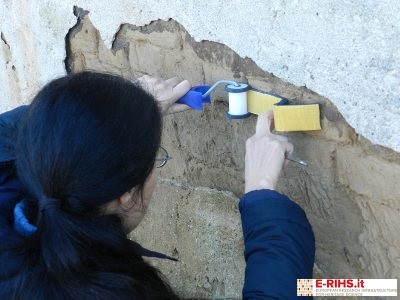
LABORATORY: CNR ISPC
NAME OF THE INSTRUMENT
Peeling method
GENERAL DESCRIPTION
The peeling test was designed as a method for verifying the dusting of paints. In the field of Cultural Heritage, its first applications concern verifying the effectiveness of treatments aimed at restoring cohesion to the pictorial surface of frescoes. Subsequently, it was applied on mortars (lime, cement, earth) always to verify the surface re-adhesion induced by conservative treatments.
TECHNICAL DESCRIPTION
To perform the peeling test, an adhesive tape with high homogeneity and known characteristics is used, with particular regard to tensile and adhesion strength in accordance with the ASTM D3759 and ASTM D 3330 standards respectively (e.g. 3M scotch 1280). An analytical balance with three decimal units and an instrument to have a homogeneous pressure of the tape on the surface are other tools used for the test. The adhesive tape is cut so as to have a certain test surface (e.g. 7x2cm), it is weighed and applied to the surface with constant pressure, and then removed, taking care to maintain a constant peeling speed.
The removed adhesive tape is weighed and the difference with the weight previously acquired allows evaluating the quantity of material removed. All these operations are repeated in the same area at least 5 times using a new adhesive tape each time. By doing so, it is possible to observe a cohesion trend with subsequent peeling and compare untreated areas with treated areas.
This technique is an effective method for determining the state of surface cohesion of much disintegrated materials or with an important surface dusting, also including soft stones, such as limestone tuffs, with similar types of degradation and to verify the effectiveness of treatments (made to avoid the dusting of the surface).
Referent:
Oana Adriana Cuzman oanaadriana.cuzman@cnr.it
